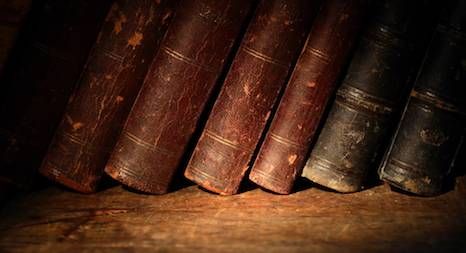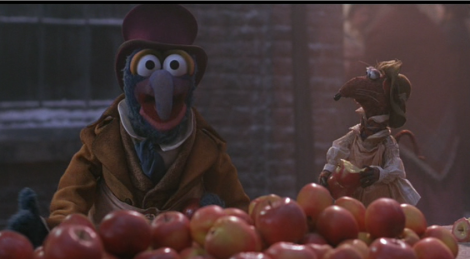
Old Books Are Weird
Lisa Ruiz is a writer, cat mom, sick person, sewist, and proud aunt living in arid Southern California. You can find her at her personal blog or on Twitter.
One of the most delightful things about reading old books is the element of the bizarre. I know that “we all bleed red” or whatever, but there are so many instances when I have to pause in my reading and be like, “what the hell?!”
For example: in A Christmas Carol, the ghost of Christmas present is a jolly Santa-like figure, similar to the way he is portrayed in numerous adaptations. (Side note: The Muppet Christmas Carol is one of the very few movies that’s better than the book. For more opinions about the muppets presented as objective facts, contact me). The difference is in what he’s wearing. Here is Dickens’s description: “It was clothed in one simple green robe, or mantle, bordered with white fur. This garment hung so loosely on the figure, that its capacious breast was bare, as if disdaining to be warded or concealed by any artifice.” So, he’s wearing a green robe AND NOTHING ELSE. Totes normal and clearly a representation of his…honesty. Then later, Scrooge notices something. “…I see something strange, and not belonging to yourself, protruding from your skirts. Is it a foot or a claw?” This is that “what the hell?!” moment I was talking about. First of all, he’s not wearing anything, so…WHY DOES HE HAVE SOMETHING PROTRUDING FROM HIS SKIRTS?! And why does Scrooge think it’s appropriate to ask about it? Why on earth would it be a claw? And it just gets weirder from there. It turns out it was two scrawny, dirty, sad children hanging out under his robe. I swear to Shakespeare I’m not making this up. The two children are personifications of ignorance and want, and the ghost uses their introduction as a way to teach Scrooge a lesson. But still. An old dude who is NOT A VILLAIN wearing only a bathrobe and hiding two sad children under it is pretty damn bizarre. Could you imagine anything even remotely similar to this happening in a popular novel today?
The bizarre in old books isn’t limited to things you can chalk up to differences in iconography, though. There is plenty of opportunity for some major moral side-eye. Let’s take an example from another beloved classic this time: Pride and Prejudice. So, the major action of the final part of the story revolves around Lizzie’s distress about Lydia running off with a cad named Wickham and Darcy saving the day by paying Wickham to marry Lydia. Yay, Darcy did it all for Lizzie and now they can get married and the rest of the Bennet girls will remain untainted by Lydia’s disgrace! Only…not yay? Like, it worked out pretty well for Lizzie and her sisters, but fifteen-year-old Lydia is now married to a genuinely terrible person. The rest of her life looks pretty bleak, and it’s all because of some silliness and mistakes she made when she was a young teen. There’s also a sense that the fates of Lizzie and her sisters are totally out of their control. If they lose their reputation or choose the wrong husband, the rest of their lives will be bleak, too. And that’s not because being single sucks, it’s because marrying is the only way they can procure their own money and have a chance at directing their own lives. And judging from the examples of the married women who populate Austen’s novels, that chance is pretty slim. So, even though it feels triumphant when Lizzie discovers it was Darcy who rescued Lydia from disgrace, it’s bizarre and sad that Lydia’s mistakes, which wouldn’t be a huge deal today, ruined her life, and could have ruined so many more.
Reading old books for my English major in undergrad often felt kind of like reading lit for my French minor. Ebenezer Scrooge and Lydia Bennet and Jean-Paul Sartre and Joseph Zobel live in very different worlds from mine. Slipping into a perspective that is steeped in a culture different from my own is not only fascinating; it is, by turns, provocative, touching, educational, funny, and disturbing. Considering these perspectives is kind of like taking off my cultural glasses and rubbing them clean; when I put them back on, I see more clearly than before.















